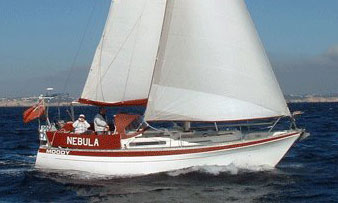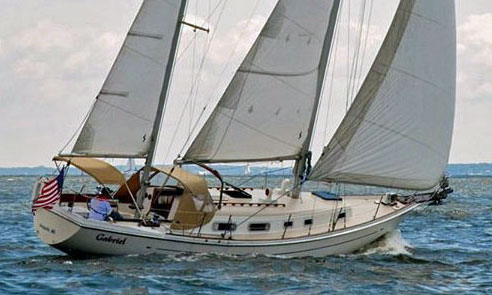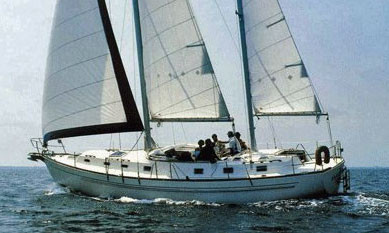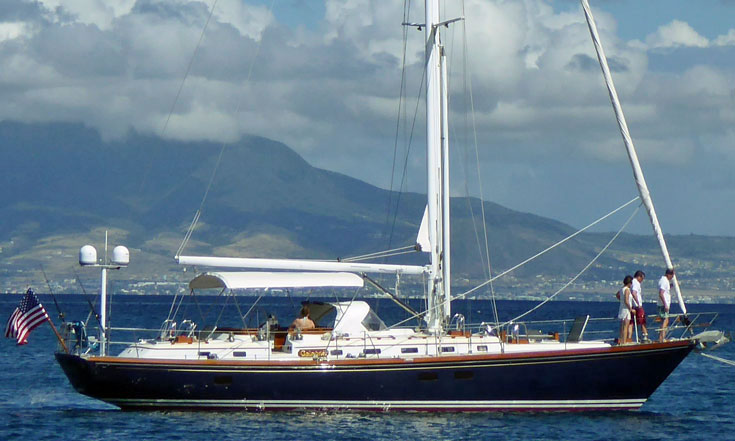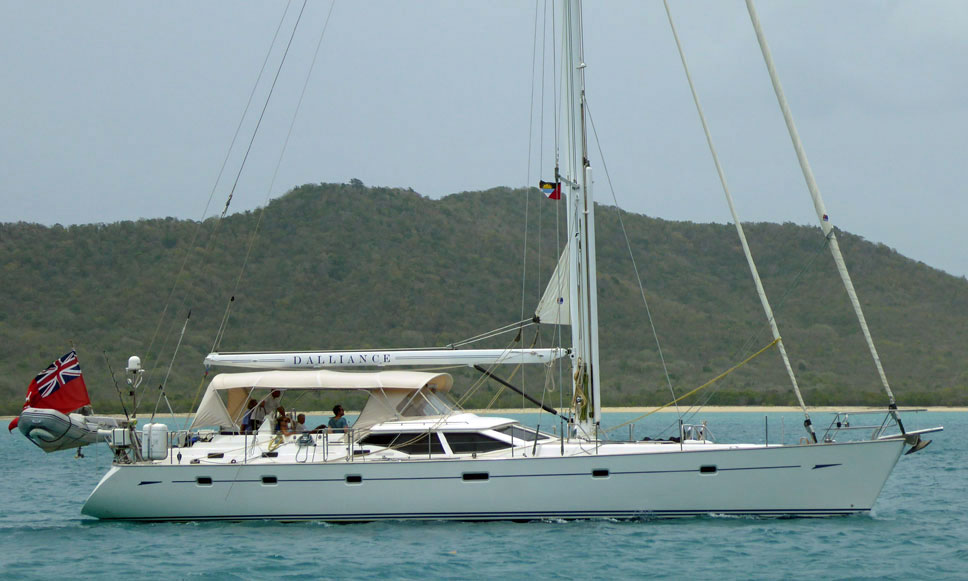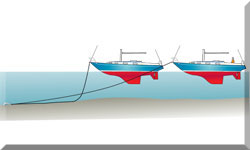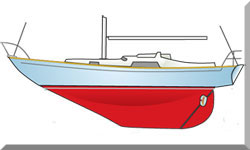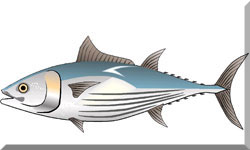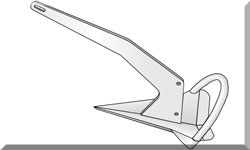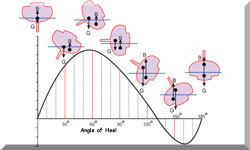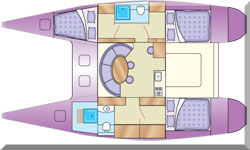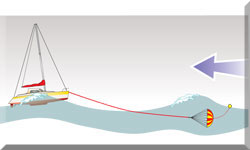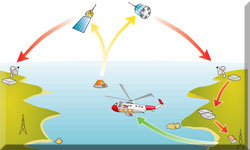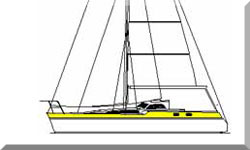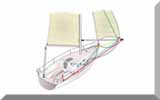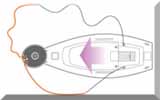- Home
- Cruising Yachts 45' to 50'
- Beneteau 463 Sailboat Specs
The Beneteau 463 Sailboat
Specs & Key Performance Indicators
The Beneteau 463 sailboat was designed by Bruce Farr & Armel Briand and manufactured by Beneteau in France throughout the years 1998 to 2000.
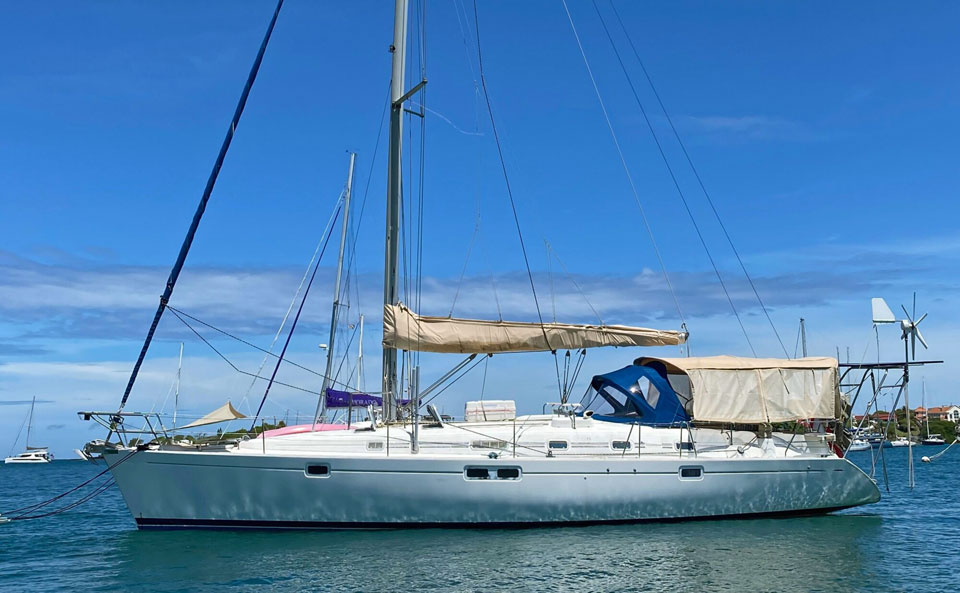 The Beneteau 463
The Beneteau 463Published Specification for the Beneteau 463
Keel & Rudder Configuration: Fin keel with spade rudder
Hull Material: Fiberglass
Length Overall: 14.2m (46'7")*
Waterline Length: 12.7m (41'8")*
Beam: 4.25m (13'11")*
Draft: 1.75m (5'9")*
Rig Type: Sloop
Displacement: 9,979 kilograms (22,000 pounds)*
Ballast: 3,175 kilograms (7,000 pounds)*
Sail Area: 77m2 (632ft2)*
Water Tank Capacity: 530 litres (140 US gallons)
Fuel Tank Capacity: 200 litres (53 US gallons)
Hull Speed: 8.6 knots
Designer: Bruce Farr & Armel Briand
Builder: Beneteau
Year First Built: 1996
Year Last Built: 2000
Number Built: Approximately 200
* Used to derive the design ratios referred to later in this article - here's how they're calculated...
Options & Alternatives
Draft: The Beneteau 463 was available with a standard deep draft keel and an optional shallow draft keel. The deep draft version had a draft of approximately 1.75 meters (5'9"), while the shallow draft version had a draft of around 1.60 meters (5'2").
Layout: The Beneteau 463 offered different interior layout options to cater to various needs. Buyers could choose between a three-cabin layout with two heads or a four-cabin layout with three heads. The three-cabin layout featured a spacious owner's cabin forward with an en-suite head, while the four-cabin layout provided additional sleeping quarters for larger crews.
Later Versions: There were later versions of the Beneteau 463 produced. One notable version is the Beneteau Oceanis 461, which shares many similarities with the Beneteau 463 but includes some updates and improvements. The Oceanis 461 was introduced in 1997 and continued production beyond the 463's end in 2000.
Essential Differences:
- Design and Layout: The Oceanis 461 featured a more modern design with updated interior layouts and finishes. It offered similar cabin configurations but with improved ergonomics and aesthetics.
- Performance: The Oceanis 461 had slight modifications to the hull and rigging to enhance sailing performance and handling.
- Equipment and Features: The newer version included updated equipment and features, such as improved navigation systems, better ventilation, and more efficient use of space.
The Beneteau 463 was also produced as Moorings 463. They are essentially the same boat, with the Moorings 463 being a version tailored for the charter market. The differences are subtle and mainly focused on ease of maintenance and durability for charter use. The Moorings 463 may have additional features or modifications specified by the charter company
Sail Areas & Rig Dimensions
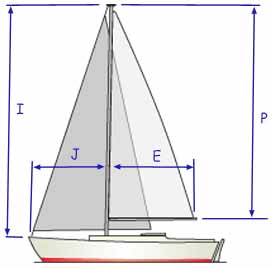 Sail Areas & Rig Dimensions
Sail Areas & Rig Dimensionswhere
- “I” is measured along the front of mast from the highest halyard to the main deck. The main deck is where the deck would be if there were no deckhouse;
- “J” is the base of the foretriangle measured along the deck from the headstay to the mast;
- “P” is the luff length of the mainsail, measured along the aft face of the mast from the top of the boom to the highest point that the mainsail can be hoisted;
- “E” is the foot length of the mainsail, measured along the boom from the after face of the mast to the outermost point on the boom to which the main can be pulled.
Sail Areas
- Total Sail Area: 77.3m2 (832ft2)
- Mainsail Area: 36.9m2 (397ft2)
- Foresail Area: 40.4m2 (435ft2)
Rig Dimensions
- I (foretriangle height): 16.62m (54'6")
- J (foretriangle base): 4.86m (15'11")
- P (mainsail luff length): 14.19m (46'7")
- E (mainsail foot length): 5.20m (17'1")
Published Design Ratios
The Key Performance Indicators (KPIs)
Sail Area/Displacement Ratio (SA/D) of 17.5: This ratio indicates the sailboat has a moderate amount of sail area relative to its displacement. A higher SA/D suggests better light-wind performance and a more powerful sail plan. The Beneteau 463, with its SA/D of 17.5, balances power and handling, making it suitable for various wind conditions and providing good overall performance.
Ballast/Displacement Ratio (B/D) of 35.8%: This ratio reflects the proportion of the boat's weight that is dedicated to ballast, contributing to the vessel's stability. A B/D ratio of 35.8% indicates the Beneteau 463 has a respectable amount of stability. This translates to a sailboat that can handle a range of sea conditions and remain relatively stable and comfortable for cruising.
Displacement/Length Ratio (D/L) of 153.2: The D/L ratio assesses the boat's hull form and its theoretical speed potential. A lower D/L ratio generally suggests a lighter and faster hull design. With a D/L ratio of 153.2, the Beneteau 463 is considered a moderately light cruiser, offering a good balance between speed and carrying capacity for longer voyages.
Comfort Ratio of 23.1: This ratio is an indicator of the boat's motion comfort in rough sea conditions. The higher the comfort ratio, the more comfortable the boat is expected to be in choppy waters. A comfort ratio of 23.1 suggests that the Beneteau 463 should provide a reasonably comfortable ride in various sea states, making it a good choice for extended cruising.
Capsize Screening Formula (CSF) of 2.0: This formula is used to assess a boat's likelihood of capsizing in heavy seas. A CSF value below 2 is generally considered safe for ocean-going vessels. The Beneteau 463, with a CSF of 2.0, is on the threshold but still within acceptable limits for offshore cruising, indicating it can handle challenging conditions with competent seamanship.
But the Design Ratios Don't Tell the Whole Story...
Although the design ratios can be interpreted to provide an indication of such a vessel's likely sailing characteristics they do however, have their limitations:
- The design ratios are static measurements which don't account for dynamic factors like wave action, wind gusts, or crew actions.
- They simplify complex interactions into single numbers, which can be misleading. Real-world performance is influenced by a multitude of factors that these ratios can't fully capture.
- The context in which the boat is intended to be used (e.g., coastal cruising vs. offshore racing) can greatly affect how these ratios should be interpreted.
Consequently, while these ratios provide valuable insights into the theoretical performance characteristics of a sailboat, they should be used as part of a broader assessment that includes practical experience, sea trials, and expert advice.
Cruisers' Questions...
In the Beneteau range of sailboats, what are the general differences between the basic Beneteau, the First and the Oceanis ranges?
In the Beneteau range of sailboats, what are the general differences between the basic Beneteau, the First and the Oceanis ranges?
When looking at the Beneteau sailboat ranges, it's helpful to understand the general design philosophies behind each:
The Oceanis range:
- This range is primarily focused on comfortable cruising.
- Oceanis yachts emphasize spacious interiors, ease of handling, and features that enhance onboard living.
- They are designed for sailors who prioritize comfort and relaxation during their voyages.
- These are very popular for people who plan on long cruises, or live aboard their vessels.
- They are built with comfort and stability in mind.
The First range:
- The First line is geared towards performance sailing.
- These boats are designed with a focus on speed, responsiveness, and sailing enjoyment.
- While they can still be used for cruising, they prioritize sailing performance.
- Beneteau also has the "First SE" range, which is geared toward high performance sailing.
- They are designed for people who enjoy racing, and those who like a more sporty feel while sailing.
General Beneteau:
- It is important to understand that Beneteau is the brand, and Oceanis and First are ranges within the brand.
- Beneteau produces many types of boats, including power boats, so the term General Beneteau, refers to all of the boats produced by the Beneteau company.
In essence:
- If you're looking for a comfortable, relaxed cruising experience, the Oceanis range is likely a good fit.
- If you prioritize sailing performance and a more sporty feel, the First range is designed for you.
Why do Beneteau sometimes drop 'Oceanis' or 'First' as in the Beneteau 463?
Why do Beneteau sometimes drop 'Oceanis' or 'First' as in the Beneteau 463?
Older Beneteau models, like the 463, were produced during periods when the company's marketing and range classifications might have differed from today's more clearly defined lines. Over time, Beneteau has refined its branding and segmentation, leading to the more consistent "Oceanis" and "First" distinctions we see in newer models.
Did Bruce Farr design any of the Beneteau range?
Did Bruce Farr design any of the Beneteau range?
Yes, Bruce Farr and Farr Yacht Design have indeed had a significant association with Beneteau. Here's a breakdown:
Farr Yacht Design's Involvement:
- Farr Yacht Design is well-known for its expertise in designing both racing and cruising yachts.
- Beneteau has collaborated with Farr Yacht Design on numerous projects, particularly within the "First" range, which emphasizes performance sailing.
- Examples of Beneteau models designed by Bruce Farr or Farr Yacht Design include various "First" models, and also the Beneteau 50.
- It is very well known that the Farr design team has had a long relationship with Beneteau.
Key Points:
- Farr's designs are recognized for their performance and efficiency.
- The collaboration between Beneteau and Farr has resulted in many popular and successful sailboat models.
Therefore, it's accurate to say that Bruce Farr and Farr Yacht Design have played a notable role in the design of certain Beneteau sailboats.
Did Beneteau build boats outside of France?
Did Beneteau build boats outside of France?
Yes, Beneteau does have production facilities outside of France. Here's a general overview:
International Production:
Groupe Beneteau, the parent company, has international production capacities to serve various regional markets.
They have production sites in various locations, including:
- France
- Italy
- Poland
- Portugal
- Tunisia
- The United states.
Past US Production:
Beneteau previously had a production facility in Marion, South Carolina, which built boats for the American market. However that facility has been closed, and production has been moved back to the facilities in France.
Groupe Beneteau's Global Presence:
It's important to remember that Beneteau is part of Groupe Beneteau, which has a widespread global presence. This means that while some models are primarily built in France, the company has a network of production sites to meet international demand.
In summary, while Beneteau has a strong foundation in France, it also has a history of, and currently has, international production to serve its global customer base.
More Specs & Key Performance Indicators for Popular Cruising Boats
This article was written with the assistance of Copilot, a large language model developed by Microsoft. Copilot was used to gather information, summarize research findings, and provide suggestions for the content and structure of the article.
Recent Articles
-
Yacht Clearance in the Caribbean: A Sailor's Guide
Nov 25, 25 07:13 AM
Navigating yacht clearance in the Caribbean is essential for a smooth sailing trip. This guide, written by an experienced sailor, explains the required papers, procedures & tips for a hassle-free expe… -
Beneteau Oceanis 36CC: Specs, Ratios & Cruising Suitability
Nov 25, 25 06:08 AM
Detailed analysis of the Beneteau Oceanis 36CC centre cockpit sailboat. Includes design ratios, full specifications, and practical assessment of its suitability for experienced offshore and liveaboard… -
Essential Boat Toilet Maintenance & Systems: A Sailor’s Guide
Nov 24, 25 01:17 PM
Master boat toilet maintenance, from manual sea heads to 12v electric systems. Get an experienced offshore sailor’s guide on avoiding clogs, leaks, & bad smells.

